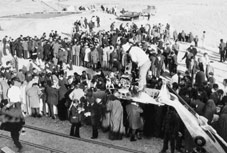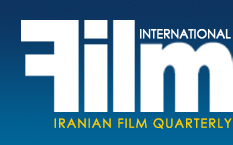|
Extras in the Iranian cinema
Defenseless Lovers of Cinema
by Habib Hekmat
|
 The word “extras” was introduced to the Iranian cinema in late 1940s. It was made common by Dr. Esmaeil Koushan, one of the biggest producers of pre-revolution era, who promoted popular cinema by making such films as The Storm of Life (Ali Darya Beigi) and The Prisoner of the King (Esmaeil Koushan). In those films, protagonists and villain characters needed a lot of people to stand behind them to make them more prominent and add to dramatic attractions of the movie. Koushan continued making popular films for the Iranian cinema for more than half a century and produced more than 90 films at Mitra Film and Pars Film studios. More than half of his films revolved around historical themes and needed to be populous and glamorous. In this way, extras were established as a job in the Iranian cinema. However, as enthusiasm for historical films faded, extras changed form. As films like Qarun’s Treasure and Qaysar become popular, extras appeared as people who were beaten by leading characters of those films. Under supervision of directors, they posed before protagonists or villain characters and where thrown around with every punch or kick of the leading characters. In this way, some champions of martial arts gradually appeared in films and, if their appearance was appealing, they were even cast in supporting roles. The word “extras” was introduced to the Iranian cinema in late 1940s. It was made common by Dr. Esmaeil Koushan, one of the biggest producers of pre-revolution era, who promoted popular cinema by making such films as The Storm of Life (Ali Darya Beigi) and The Prisoner of the King (Esmaeil Koushan). In those films, protagonists and villain characters needed a lot of people to stand behind them to make them more prominent and add to dramatic attractions of the movie. Koushan continued making popular films for the Iranian cinema for more than half a century and produced more than 90 films at Mitra Film and Pars Film studios. More than half of his films revolved around historical themes and needed to be populous and glamorous. In this way, extras were established as a job in the Iranian cinema. However, as enthusiasm for historical films faded, extras changed form. As films like Qarun’s Treasure and Qaysar become popular, extras appeared as people who were beaten by leading characters of those films. Under supervision of directors, they posed before protagonists or villain characters and where thrown around with every punch or kick of the leading characters. In this way, some champions of martial arts gradually appeared in films and, if their appearance was appealing, they were even cast in supporting roles.
Arbab Jamshid is resort of extras. Arbab Jamshid was the name of a wealthy Zoroastrian citizen of Tehran who lived some 80 years ago. He had a very big house and garden along Lalezar Street, which was later, renamed Arbab Jamshid when the garden was converted to a street. Lalezar, which is now a big market for dealers of electrical equipment, was once one of the most modern streets of Tehran. The street abounded with symbols of modern arts and literature, including theaters, playhouses, cabarets, cultural cafés…. Even embassies of Germany, Britain and Russia were located around that street. It was greatly developed after Reza Shah was ousted from Iran in 1940s and afterwards, and many filmmaking studios were established between Lalezar and Arbab Jamshid streets. In the middle of 1950s, a group of merchants, most of whom were Indians or Jews, decided to import foreign films. For this reason, they opened offices at and around Arbab Jamshid Street. Dr. Koushan had also established his office and studio in that area and others soon joined in. As the number of studios increased (such as Mahtab Film, Azhir Film, Rex and Jurak), film buffs from Tehran and other cities went to Arbab Jamshid street and gathered in front of studios in hope of being assigned to a minor role in the Iranian films. However, they were only accepted as extras. Some of them sometimes gathered at a small square in the middle of the street and some of them went to a teahouse which belonged to a man called Mash Yousef. Mash Yousef died soon after the Islamic Revolution. His teahouse is deserted now and extras frequent another street and teahouse, which is called Mehr. Every one of them loved a famous actor and waited there until their favorite actor came by and they could pose for a photo with them. At present, Arbab Jamshid Street is full of shops selling handbags, leather and cosmetics and only few deserted buildings have remained from all those film production studios. In fact, as studios where closed down one after the other following victory of the Islamic Revolution, extras gradually left the street and conscripts or even civil servants were used for films which needed a great number of extras. After the revolution, movie lovers left Arbab Jamshid and moved to other places. During Iran-Iraq war, some of them gathered in places where war refugees were living to act as extras in war films. Afterwards, other locations in south Tehran such as Shoush Square or even around Tehran’s public graveyard (Behesht-e Zahra) were frequented by those people.
...
SUBSCRIBE
[Page: 54]
|
|
|
|
|
President & Publisher
Massoud Mehrabi
Editors:
Sohrab Soori
Translators:
Sohrab Soori
Behrouz Tourani
Zohreh Khatibi
Contributors
Shahzad Rahmati
Saeed Ghotbizadeh
Advertisements
Mohammad Mohammadian
Art Director
Babak Kassiri
Ad Designers
Amir Kheirandish
Hossein Kheirandish
Cover Design
Alireza Amakchi
Correspondents
E.Emrani & M. Behraznia (Germany)
Mohammad Haghighat (France)
A. Movahed & M. Amini (Italy)
Robert Richter (Switzerland)
F. Shafaghi (Canada)
B. Pakzad (UAE)
H. Rasti (Japan)
Print Supervisors
Ziba Press
Gol-Naghdh Press
Blue Silver
Subscription & Advertising Sales
Address: 10, Sam St., Hafez Ave., TEHRAN, IRAN
Phone: +98 21 66722444
Fax: +98 21 66718871
info@film-magazine.com
Copyright: Film International
© All rights reserved,
2023, Film International
Quarterly Magazine (ISSN 1021-6510)
Editorial Office: 5th Floor, No. 12
Sam St., Hafez Ave., Tehran 11389, Iran
*
All articles represent views of their
authors and not necessarily
those of the editors.
|
|
|

